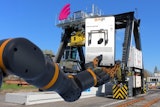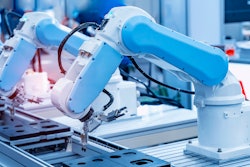
After a global pandemic shut down much of the manufacturing sector, the future is looking brighter for the industry. In fact, projections from Deloitte’s 2022 Manufacturing Outlook Report anticipate more than 4% GDP growth in U.S. manufacturing this year.
However, along with the uptick in growth comes some challenges. Deloitte notes that manufacturers face a confluence of issues including increased consumer demand, rising costs of materials and shipping, and trucking driver shortages, all of which end up increasing costs, which are then passed on to consumers.
Another major factor threatening manufacturers’ success is the record number of unfilled positions at factories across the country. This threatens to limit productivity and overall output potential for 2022. Last year, Deloitte predicted there would be 2.1 million open skilled job positions by 2030.
The news of big growth in GDP across the U.S. manufacturing sector, combined with the complex hurdles mentioned above, requires companies to create and execute operational policies that put a new premium on agility and efficiency.
Every manufacturing business knows that time is money. This applies to components sitting in a container in a California port, or the length of time it takes for these parts to make it to the factory. Adhering to strict timelines to meet order deadlines and shipping schedules are imperative to manufacturer revenues, and the inability to meet contract commitments could irreparably harm brand reputation.
Achieving business efficiencies and seamless productivity requires tight integration between front office operations and the manufacturing floor, connecting ERP systems with HR, sales, shipping, and more. Digitizing processes across the manufacturing organization can create new levels of efficiencies and coordination between every department, as well as with customers and supply chain partners.
Digitizing from the Corporate Office to the Factory Floor
Luckily, the efforts to modernize and digitize manufacturing factory floor and back-office operations continue to accelerate, helping manufacturers get closer to reaching their efficiency goals. Deloitte calls taking a 360-view at digitizing -- from the factory floor to corporate office functions -- “smart factory initiatives.”
Through investment in technologies such as AI, robotics, and cloud computing, manufacturing businesses will be able optimize the resources they have on hand. This couldn’t be more timely given the unprecedented number of skilled positions yet to be filled.
According to Deloitte, 45% of manufacturing executives surveyed expect further increases in operational efficiency from investments in Industrial Internet of Things (IIoT), which connects machines and automates processes. As organizations continue to digitize and automate, connecting ERP systems from the manufacturing floor to CRM and HR platforms in the corporate office, businesses will benefit from the seamless flow of information between departments.
Some of the ways digitization can drive agility, efficiency and productivity in manufacturing include:
- Reducing paper and driving faster decision-making– Although the “Manufacturing 2.0” movement was slowed by COVID-19, it’s more important than ever now due to a sudden increase in demand combined with supply chain and labor shortages. The bottom line is that manufactures need to have real-time data to increase production output for the products their customers demand, ensuring that they have the right components at the right time. For example, document scanning and AI allow paper-based information to quickly and accurately transform into actionable data that can drive workflow processes that enhance worker productivity and manufacturing capacity. By using a combination of hardware and software solutions, employees can scan and capture documents, which are then integrated into other digital systems and manufacturing platforms to provide a more modern, secure, and transparent method of dealing with documentation. This allows for faster decision-making with real-time transit and inventory information, while the capture of backup documentation, including material inspection sheets, drives more speedy receiving processes, accelerating the production process.
- Creating a sustainability-minded corporate culture – Scaling back on paper consumption also supports manufacturers’ sustainability policies. The urgency of adopting more “green” processes across all corners of the business becomes even more imperative as investors, customers, employees, and policymakers continue to drive the discussion around climate change and reducing organizations’ carbon footprint. In addition, the ability to leverage valuable real estate for other purposes allows manufacturers to expand new critical business-related process, such as accounting or procurement.
- Supporting today’s (and tomorrow’s) work ecosystem – The traditional workplace was upended due to Covid-19, impacting companies across every industry – particularly manufacturers. Even though much of the world is back in the office or on the factory floor either part- or full-time, it’s likely that the hybrid work model will become the new normal over the next year. According to a report from Manufacturers Alliance, 80% of the manufacturers they surveyed expect their organizations to formalize a remote and in-person work model over the next year – a 7x increase from pre-pandemic. Digitizing processes supports flexible work models by giving employees unprecedented access to documentation and enabling secure, easy access to files from anywhere, whether employees are in the office or working remotely. While accessibility is the most important factor, the ability to manage hardware and software solutions from a central location makes operations more agile, enabling remote device management, including firmware updates, and gaining more control over paperwork and workflows.
There’s little doubt that manufacturing is going through an era of transformation. While change is always challenging, manufacturers have a new opportunity for growth and expansion by adopting technologies and processes that will allow them to meet these challenges head on.
By looking forward instead of backward, manufacturers can create the factory of the future – one that enables them to compete, win, and succeed in a dynamic global market.
---
Scott Francis, Technology Evangelist at PFU America, Inc., brings more than 30 years of document imaging expertise to his position where he’s responsible for evangelizing Fujitsu’s industry leading scanner technology. With over thirty years of experience in the enterprise content management industry, he frequently provides thought leadership on document scanning use cases and best practices in addition to the overall benefits of digital transformation solutions.























